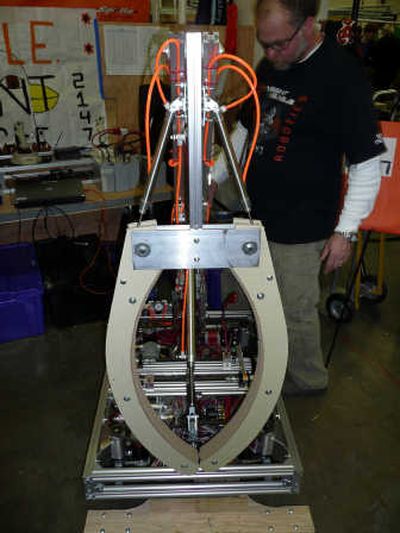WVHS has robot fever

The Agent Eagle robotics team at West Valley High School is fresh from one competition in Portland and about to leave for another one in Tacoma.
At the recent competition at the end of February the team came in 20th out of 54. “We didn’t rank,” said team member Hayley Lune, a junior. “It sounds bad, but our robot did a lot better than last year.”
This is the robotics team’s second year in existence and the students have responded enthusiastically to the chance to build their own robot and compete with it. “They do great,” said team leader and teacher Brad Liberg. “There’s room for all kinds of kids in the program.”
The next competition in Tacoma begins on Thursday. The game this year is for the robots to get a large ball down from an overhead rack and push it around the course, gaining points along the way. “Every year the game changes,” said Lune. “Every year your robot has to do something different, so you have to build a new robot each year.”
This year the teams were assigned alliances, so teams had to work together. “You might compete against a team in one match and work with them in the next,” Lune said. Plus, robots could also gain points just by moving around the course. “Any robot that runs can score points.”
Some teams took advantage of that and didn’t even bother with pushing the balls. “There were some robots that were really small and just ran around,” said Henrique Dantas, a senior exchange student from Portugal.
Points were also deducted for contact between robots. “There were lots of times when we won but we accidentally bumped a robot when we shouldn’t have,” Lune said.
Teams around the country are given only six weeks to build their robot. They don’t get the robots back in between competitions, so teams can’t tinker as they go. This year’s robot is nearly 120 pounds, which is the limit for a robot its size. “With our arm working it can reach over the rack, and it’s six feet high,” said team member Kassie McKnight, also a junior.
“We hit every maximum we could,” said Dantas.
The group got its start in the fall of 2006 when Altek Machining got a group of teachers together and presented information on the FIRST robotics program. West Valley was able to get a $6,000 grant from NASA last year and this year to make it work, Liberg said. The FIRST program and the local companies involved want to inspire kids to get involved in science and engineering fields, he said. “There’s a lot of relevance in it. They get to do a little bit of what engineers do out there.”
Several local companies provide technical assistance and parts, working with the students as they build their robot. “We’ve never been turned down by a manufacturer,” Liberg said. “You couldn’t do it without the support of industry.”
Liberg said he was surprised at how eager kids were for the robotics program. “It’s a lot more mainstream,” he said.
Lune said she joined the team in its rookie year for the chance to participate in an academic activity. Dantas said it wasn’t only the robots that drew him in. “I’m here as an exchange student and I wanted to travel,” he said. “I knew they were going to competitions.”
Only 10 students were able to attend the Portland competition, but the whole team of 27 is heading to Tacoma. There will only be 34 teams in that competition. “We have a way better chance of making the finals,” Lune said.
Liberg sees only bigger and better things in the future for his team. “We’re recruiting more staff to help,” he said. “We want this to be a long-term program.”